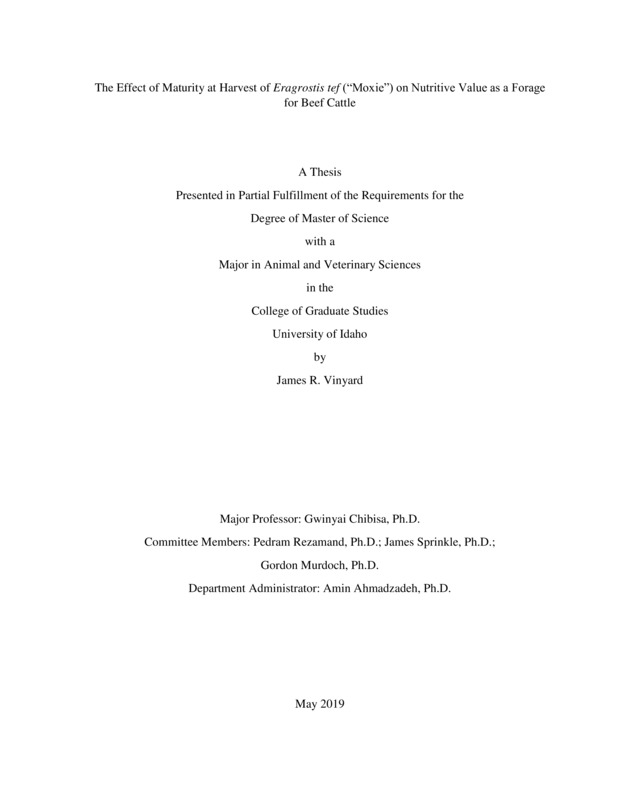The Effect of Maturity at Harvest of Eragrostis tef (“Moxie”) on Nutritive Value as a Forage for Beef Cattle
Vinyard, James. (2018-12). The Effect of Maturity at Harvest of Eragrostis tef (“Moxie”) on Nutritive Value as a Forage for Beef Cattle. Theses and Dissertations Collection, University of Idaho Library Digital Collections. https://www.lib.uidaho.edu/digital/etd/items/vinyard_idaho_0089n_11457.html
- Title:
- The Effect of Maturity at Harvest of Eragrostis tef (“Moxie”) on Nutritive Value as a Forage for Beef Cattle
- Author:
- Vinyard, James
- Date:
- 2018-12
- Keywords:
- beef cattle nitrogen utilization nutritive value ruminal digestibility teff
- Program:
- Animal and Veterinary Science
- Subject Category:
- Animal sciences
- Abstract:
-
Teff (Eragrostis tef ; ‘Moxie’), a warm-season annual grass, could be an excellent forage for beef cattle. However, there is limited information on its nutritive value to cattle when harvested at different stages of maturity. Thus, the objective of this research was to determine the effect of feeding teff hay harvested at the boot (BT), early-heading (EH), or late-heading (LH) stages of maturity on nutrient intake, ruminal fermentation characteristics, omasal nutrient flow, and N utilization in beef cattle. Six ruminally cannulated beef heifers were used in a replicated 3 × 3 Latin square design with 28-d periods (18 d for adaptation and 10 d for measurements). Dietary treatments were BT, EH, or LH teff hay. Dry matter intake was measured daily. Indwelling pH loggers were used to measure ruminal pH from d 21 to 28. Ruminal fluid and omasal digesta were collected from d 26 to 28 to determine fermentation characteristics and omasal nutrient flow. Fecal and urine samples to quantify N excretion were also collected (d 26 to 28). Blood samples were collected 3 h post-feeding on d 28. There were no changes (P > 0.28) in the ADF or NDF content of teff with advancing maturity but iNDF increased (P < 0.01) with increasing maturity. Maturity had no effect (P ≥ 0.14) on DMI, and ruminal total short-chain fatty acid (SCFA) concentration, pH, digestibility and outflow of DM, OM, NDF, ADF, and CP. However, the CP content of BT hay was greater (P < 0.01) than for EH and LH hay (18.1, 14.1, and 11.5%, respectively, DM basis), and this resulted in the higher CP intake (P < 0.01) for heifers fed the BT than the EH and LH hay. Consequently, ruminal ammonia-N (NH3-N) concentration was greater (P < 0.01) for heifers fed BT than EH and LH hay, thereby possibly explaining the tendency for a decrease (P = 0.08) in PUN concentration, and a decrease (P < 0.01) in the excretion of total N, urine N and urea-N (UUN) with advancing maturity. However, fecal N excretion (g/d) did not differ (P = 0.76). In conclusion, despite a decrease in CP intake and ruminal
NH3 -N concentration, feeding beef heifers EH and LH compared to BT teff hay did not compromise ruminal digestion and outflow of DM, OM, NDF, ADF, and CP, and microbial protein synthesis. Advancing maturity in teff hay also resulted in a decrease in the excretion of total N and urine N and UUN when fed to cattle. Therefore, beef producers could wait until the LH stage to harvest/graze ‘Moxie’ teff grass to maximize forage yield without severely compromising its nutrient value.
- Description:
- masters, M.S., Animal and Veterinary Science -- University of Idaho - College of Graduate Studies, 2018-12
- Major Professor:
- Chibisa, Gwinyai E
- Committee:
- Rezamand, Pedram; Murdoch, Gordon K; Sprinkle, James E
- Defense Date:
- 2018-12
- Identifier:
- Vinyard_idaho_0089N_11457
- Type:
- Text
- Format Original:
- Format:
- application/pdf
- Rights:
- In Copyright - Educational Use Permitted. For more information, please contact University of Idaho Library Special Collections and Archives Department at libspec@uidaho.edu.
- Standardized Rights:
- http://rightsstatements.org/vocab/InC-EDU/1.0/

